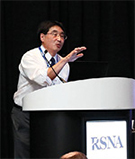The Reality of Deep Learning/Artificial Intelligence in Radiology: They Will Redefine the Specialty
Paul Chang, MD, discusses the role of machine learning in radiology including the need to build the necessary infrastructure

While there has been a lot of hype — and even fear — about the role deep learning (DL) and artificial intelligence (AI) play in radiology, the reality is that they are both potentially useful technologies that will add value to the specialty in a number of ways.
“Deep learning is not going to replace us,” said Paul Chang, MD, of the University of the Chicago School of Medicine, during an RSNA 2017 session. “But it will redefine us.”
And radiology will need this technology more than ever due to the increasing demands on clinical imaging. Data sets are getting more complex and there is an increasing need to correlate images with other clinical information in order to implement practices such as radiogenomics, Dr. Chang said.
“So deep learning will help us because we are going to need something — we need some tool — some mechanism — to meet these new imaging challenges,” Dr. Chang said. “We are going to need some kind of cybernetic help to get through a day’s work and help us maintain and improve quality."”
Infrastructure Remains a Challenge
But these are early days when it comes to incorporating DL and AI into the practice of radiology, and numerous challenges still exist.
For example, how can radiology confidently validate the performance of these new technologies?
“Deep learning is a great name for it because it has two meanings,” Dr. Chang said. “It can mean ‘very capable’ or deep as in ‘deep waters’ or ‘obscure,’ and that’s the problem.
“There are very deep layers to deep learning systems and it’s very difficult to understand why they work.”
Comprehending DL requires the use of cases and tons of data.
But radiologists really can’t get compelling use cases unless they have the necessary data and infrastructure, Dr. Chang said.
Which brings up another challenge. Radiology doesn’t have the infrastructure to either feed, train or consume these systems.
“Other industries have really revved up for cloud computing and big data and are ready to consume deep learning, because deep learning loves that kind of environment,” Dr. Chang said. “Radiology is still struggling with electronic medical records and PACS and we generally don’t have a true IT infrastructure that can feed and consume these systems.”
The specialty should first pursue a “hedge strategy” by building infrastructures necessary to prepare for the cloud and big data, registries and advanced analytics, as well as DL, he said.
Dr. Chang offers an analogy: “During the Gold Rush,” he said, “everyone went out west to dig for gold. Most miners either failed or died, but there were people who thrived — the people selling the miners the shovels.”
“The bottom line is that deep learning won’t replace people — it will enhance them,” Dr. Chang said. “We should be looking for the minimally heuristic use case sweet spot like workflow optimization. Something that isn’t sexy, but is an easy win, saves money, and improves lives.”
Web Extras
- View a video interview with Dr. Chang discussing machine learning at RSNA 2017 at Facebook.com